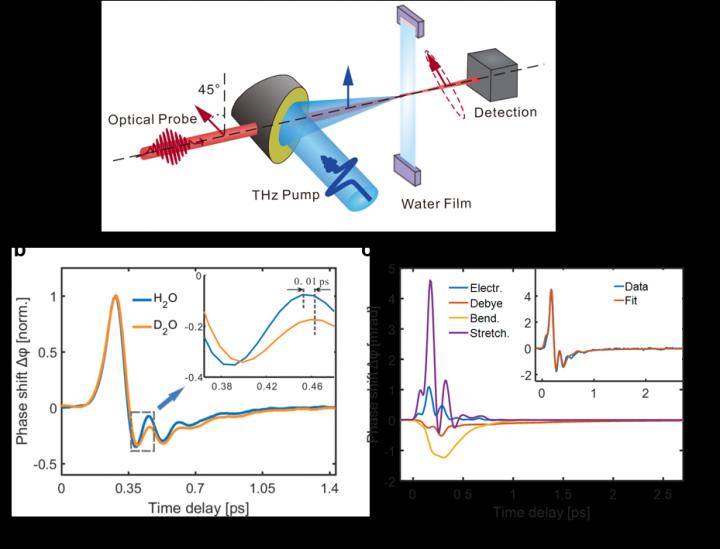
Credit: Hang Zhao, Yong Tan, Liangliang Zhang, Rui Zhang, Mostafa Shalaby, Cunlin Zhang, Yuejin Zhao, and Xi-Cheng Zhang
Liquid water is considered the cornerstone of life and has many extraordinary physical and biochemical properties. The hydrogen bond network of liquid water is widely recognized to play a crucial role in these properties. Due to the complexity of intermolecular interactions and the large spectral overlap of relevant modes, the study of hydrogen bond dynamics is challenging. In recent years, exciting the liquids resonantly with terahertz (THz) waves provides a new perspective for exploring the transient evolution of low-frequency molecular motion. However, water has a large absorption coefficient in THz band, the application of the THz-induced Kerr effect technique in hydrogen bond dynamic research has remained challenging.
In a new paper published in Light Science & Application, a team of scientists, led by Professor Yuejin Zhao from Beijing Key Laboratory for Precision Optoelectronic Measurement Instrument and Technology, School of Optics and Photonics, Beijing Institute of Technology, China; Professor Liangliang Zhang from Beijing Advanced Innovation Center for Imaging Technology and Key Laboratory of Terahertz Optoelectronics (MoE), Department of Physics, Capital Normal University, China; and co-workers used an intense and broadband THz pulse to resonantly excite intermolecular modes of liquid water and obtained bipolar THz field-induced transient birefringence signals by adopting a free-flowing water film. They proposed a hydrogen bond harmonic oscillator model associated with the dielectric susceptibility and combined it with the Lorentz dynamic equation to investigate the intermolecular structure and dynamics of liquid water. They mainly decompose the bipolar signals into a positive signal caused by hydrogen bond stretching vibration and a negative signal caused by hydrogen bond bending vibration, indicating that the polarizability perturbation of water presents competing contributions under bending and stretching conditions. The results provide an intuitive time-resolved evolution of polarizability anisotropy, which can reflect the intermolecular modes of liquid water on the sub-picosecond scale.
The THz waves can resonantly excite one or several molecular motion modes in liquids, which is a powerful tool for exploring low-frequency molecular dynamics. These scientists summarize the principle of their work:
“We used a THz electric field to resonantly excite the intermolecular modes of liquid water. The transient rotation of a molecule produces an induced dipole moment, which immediately transfers the momentum driven by the THz field to the restricted translational motion of adjacent water molecules. This translational motion can be assigned to a bending mode and a stretching mode, which can lead to the components of polarizability anisotropy perpendicular and parallel to the hydrogen bonds, respectively, thus resulting in bidirectional performance.”
“In the experiment, an intense THz excitation source and an ultrathin flowing water film that replaces traditional cuvettes are the basis for achieving high-quality signals.” they added.
“The ultrafast intermolecular hydrogen bond dynamics of water revealed by a broadband THz pump pulse can provide further insights into the transient structure of liquid water corresponding to the pertinent modes. This breakthrough could open a new venue for detecting the physical mechanisms of the gas phase of water and crystalline and amorphous ices, as well as the complex interaction of reagents with solvent water molecules.” the scientists forecast.
###
Media Contact
Yuejin Zhao
[email protected]
Related Journal Article
http://dx.




